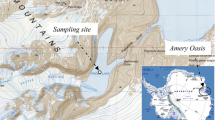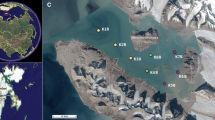Abstract
Microbial communities growing under extreme low redox conditions are present in anoxic and sulfide-rich (euxinic) environments such as karstic lakes and experience limitation of electron acceptors. The fine natural chemical gradients and the large diversity of organic and inorganic compounds accumulated in bottom waters are impossible to mimic under laboratory conditions, and only a few groups have been cultured. We investigated the bacterial composition in the oxic-anoxic interface and in the deep waters of three sulfurous lakes from the Lake Banyoles karstic area (NE Spain) through 16S rRNA gene tag sequencing and identified the closest GenBank counterpart. High diversity indices were found in most of the samples with >15 phyla/classes and >45 bacterial orders. A higher proportion of operational taxonomic units (OTUs) of the “highest novelty” was found in the hypolimnia (38 % of total sequences) than in the metalimnia (17 %), whereas the percentage of OTUs closer to cultured counterparts (i.e., 97 % identity in the 16S rRNA gene) was 6 to 21 %, respectively. Elusimicrobia, Chloroflexi, Fibrobacteres, and Spirochaetes were the taxa with the highest proportion of novel sequences. Interestingly, tag sequencing results comparison with metagenomics data available from the same dataset, showed a systematic underestimation of sulfur-oxidizing Epsilonproteobacteria with the currently available 907R “universal” primer. Overall, despite the limitation of electron acceptors, a highly diverse and novel assemblage was present in dark and euxinic hypolimnetic freshwaters, unveiling a hotspot of microbial diversity with a remarkable gap with cultured counterparts.




Similar content being viewed by others
References
Diaz RJ, Rosenberg R (2008) Spreading dead zones and consequences for marine ecosystems. Science 321:926–929
Wright JJ, Konwar KM, Hallam SJ (2012) Microbial ecology of expanding oxygen minimum zones. Nat Rev Microbiol 10:381–394
Ekau W, Auel H, Portner HO, Gilbert D (2010) Impacts of hypoxia on the structure and processes in pelagic communities (zooplankton, macro-invertebrates and fish). Biogeosciences 7:1669–1699
Vaquer-Sunyer R, Duarte CM (2008) Thresholds of hypoxia for marine biodiversity. Proc Natl Acad Sci U S A 105:15452–15457
Triadó-Margarit X, Casamayor EO (2015) High protists diversity in the plankton of sulfurous lakes and lagoons examined by 18S rRNA gene sequence analyses. Environ Microbiol Rep. doi:10.1111/1758-2229.12324
Barberan A, Casamayor EO (2011) Euxinic freshwater hypolimnia promote bacterial endemicity in continental areas. Microb Ecol 61:465–472
Garcia-Cantizano J, Casamayor EO, Gasol JM et al (2005) Partitioning of CO2 incorporation among planktonic microbial guilds and estimation of in situ specific growth rates. Microb Ecol 50:230–241
Pedros-Alio C, Guerrero R (1993) Microbial ecology in Lake Ciso. Adv Microb Ecol 13:155–209
Gobet A, Boer SI, Huse SM et al (2012) Diversity and dynamics of rare and of resident bacterial populations in coastal sands. ISME J 6:542–553
Lynch MDJ, Neufeld JD (2015) Ecology and exploration of the rare biosphere. Nat Rev Microbiol 13:217–229
Camacho A, Vicente E (1998) Carbon photoassimilation by sharply stratified phototrophic communities at the chemocline of Lake Arcas (Spain). FEMS Microbiol Ecol 25:11–22
Casamayor EO, Lliros M, Picazo A et al (2012) Contribution of deep dark fixation processes to overall CO2 incorporation and large vertical changes of microbial populations in stratified karstic lakes. Aquat Sci 74:61–75
Lehours AC, Evans P, Bardot C et al (2007) Phylogenetic diversity of archaea and bacteria in the anoxic zone of a meromictic lake (Lake Pavin, France). Appl Environ Microbiol 73:2016–2019
Tonolla M, Peduzzi S, Demarta A et al (2004) Phototropic sulfur and sulfate-reducing bacteria in the chemocline of meromictic Lake Cadagno, Switzerland. J Limnol 63:161–170
Borrego CM, Baneras L, Garcia-Gil J (1999) Temporal variability of Chlorobium phaeobacteroides antenna pigments in a meromictic karstic lake. Aquat Microb Ecol 17:121–129
Casamayor EO, Ferrera I, Cristina X et al (2007) Flow cytometric identification and enumeration of photosynthetic sulfur bacteria and potential for ecophysiological studies at the single-cell level. Environ Microbiol 9:1969–1985
Guerrero R, Montesinos E, Pedros-Alio C et al (1985) Phototrophic sulfur bacteria in two Spanish lakes: vertical distribution and limiting factors. Limnol Oceanogr 30:919–931
Casamayor EO, Pedros-Alio C, Muyzer G, Amann R (2002) Microheterogeneity in 16S ribosomal DNA-defined bacterial populations from a stratified planktonic environment is related to temporal changes and to ecological adaptations. Appl Environ Microbiol 68:1706–1714
Lliros M, Casamayor EO, Borrego C (2008) High archaeal richness in the water column of a freshwater sulfurous karstic lake along an interannual study. FEMS Microbiol Ecol 66:331–342
Llorens-Mares T, Yooseph S, Goll J et al (2015) Connecting biodiversity and potential functional role in modern euxinic environments by microbial metagenomics. ISME J 9:1648–1661
Fillol M, Sànchez-Melsió A, Gich F, Borrego CM (2015) Diversity of miscellaneous crenarchaeotic group archaea in freshwater karstic lakes and their segregation between planktonic and sediment habitats. FEMS Microbiol Ecol. doi:10.1093/femsec/fiv020
Truper HG, Schlegel HG (1964) Sulphur metabolism in Thiorhodaceae.1. Quantitative measurements on growing cells of Chromatium Okenii. Anto Leeuw J Microbiol Serol 30:225–238
Rusch DB, Halpern AL, Sutton G et al (2007) The Sorcerer II Global Ocean Sampling expedition: Northwest Atlantic through Eastern Tropical Pacific. PLoS Biol 5:398–431
Van de Peer Y, Chapelle S, De Wachter R (1996) A quantitative map of nucleotide substitution rates in bacterial rRNA. Nucleic Acids Res 24:3381–3391
Schloss PD, Westcott SL, Ryabin T et al (2009) Introducing mothur: open-source, platform-independent, community-supported software for describing and comparing microbial communities. Appl Environ Microbiol 75:7537–7541
Edgar RC (2010) Search and clustering orders of magnitude faster than BLAST. Bioinformatics 26:2460–2461
Edgar RC, Haas BJ, Clemente JC et al (2011) UCHIME improves sensitivity and speed of chimera detection. Bioinformatics 27:2194–2200
Quast C, Pruesse E, Yilmaz P et al (2013) The SILVA ribosomal RNA gene database project: improved data processing and web-based tools. Nucleic Acids Res 41:D590–596
del Campo J, Massana R (2011) Emerging diversity within Chrysophytes, Choanoflagellates and Bicosoecids based on molecular surveys. Protist 162:435–448
Triado-Margarit X, Casamayor EO (2013) High genetic diversity and novelty in planktonic protists inhabiting inland and coastal high salinity water bodies. FEMS Microbiol Ecol 85:27–36
Core Team R (2014) R: a language and environment for statistical computing. R Foundation for Statistical Computing, Vienna, Austria
Barberan A, Casamayor EO (2010) Global phylogenetic community structure and beta-diversity patterns in surface bacterioplankton metacommunities. Aquat Microb Ecol 59:1–10
Barberan A, Casamayor EO (2014) A phylogenetic perspective on species diversity, β-diversity and biogeography for the microbial world. Mol Ecol 23:5868–5876
Newton RJ, Jones SE, Eiler A, McMahon KD, Bertilsson S (2011) A guide to the natural history of freshwater lake bacteria. Microbiol Mol Biol Rev 75:14–49
Tamames, J., J. J. Abellan, M. Pignatelli, et al. (2010) Environmental distribution of prokaryotic taxa. BMC Microbiol 10
Gies EA, Konwar KM, Beatty JT, Hallam SJ (2014) Illuminating microbial dark matter in meromictic Sakinaw Lake. Appl Environ Microbiol 80:6807–6818
Shade A, Jones SE, McMahon KD (2008) The influence of habitat heterogeneity on freshwater bacterial community composition and dynamics. Environ Microbiol 10:1057–1067
Dupont CL, Larsson J, Yooseph S et al (2014) Functional tradeoffs underpin salinity-driven divergence in microbial community composition. PLoS ONE 9, e89549
Glockner FO, Zaichikov E, Belkova N et al (2000) Comparative 16S rRNA analysis of lake bacterioplankton reveals globally distributed phylogenetic clusters including an abundant group of actinobacteria. Appl Environ Microbiol 66:5053–5065
Klepac-Ceraj V, Hayes CA, Gilhooly WP et al (2012) Microbial diversity under extreme euxinia: Mahoney Lake, Canada. Geobiology 10:223–235
Comeau, A. M., T. Harding, P. E. Galand, et al. (2012) Vertical distribution of microbial communities in a perennially stratified Arctic lake with saline, anoxic bottom waters. Scientific Reports 2
Grote J, Jost G, Labrenz M et al (2008) Epsilonproteobacteria represent the major portion of chemoautotrophic bacteria in sulfidic waters of pelagic redoxclines of the Baltic and Black Seas. Appl Environ Microbiol 74:7546–7551
Noguerola I, Picazo A, Llirós M, Camacho A, Borrego CM (2015) Diversity of freshwater Epsilonproteobacteria and dark inorganic carbon fixation in the sulphidic redoxcline of a meromictic karstic lake. FEMS Microbiol Ecol. doi:10.1093/femsec/fiv086
Van Gemerden H, Montesinos E, Mas J, Guerrero R (1985) Diel cycle of metabolism of phototrophic purple sulfur bacteria in lake ciso (Spain). Limnol Oceanogr 30:932–943
Herlemann DPR, Geissinger O, Brune A (2007) The termite group I phylum is highly diverse and widespread in the environment. Appl Environ Microbiol 73:6682–6685
Herlemann DPR, Geissinger O, Ikeda-Ohtsubo W et al (2009) Genomic analysis of “Elusimicrobium minutum,” the first cultivated representative of the phylum “Elusimicrobia” (formerly termite group 1). Appl Environ Microbiol 75:2841–2849
Gich F, Garcia-Gil J, Overmann J (2001) Previously unknown and phylogenetically diverse members of the green nonsulfur bacteria are indigenous to freshwater lakes. Arch Microbiol 177:1–10
Wrighton KC, Castelle CJ, Wilkins MJ et al (2014) Metabolic interdependencies between phylogenetically novel fermenters and respiratory organisms in an unconfined aquifer. ISME J 8:1452–1463
Wrighton KC, Thomas BC, Sharon I et al (2012) Fermentation, hydrogen, and sulfur metabolism in multiple uncultivated bacterial phyla. Science 337:1661–1665
Thompson CC, Amaral GR, Campeão M, Edwards RA et al (2015) Microbial taxonomy in the post-genomic era: rebuilding from scratch? Arch Microbiol 197:359–370
Acknowledgments
JC Auguet, M Llirós, and F Gich, are acknowledged for their field assistance. This research was funded by grants GOS-LAKES CGL2009-08523-E and DARKNESS CGL2012-32747 to EOC and ARCANOX CGL2009-13318-C02-02 to CBM from the Spanish Office of Science (MINECO) and from the financial support by the Beyster Family Fund of the San Diego Foundation and the Life Technologies Foundation to the J. Craig Venter Institute.
Author information
Authors and Affiliations
Corresponding author
Rights and permissions
About this article
Cite this article
Llorens-Marès, T., Triadó-Margarit, X., Borrego, C.M. et al. High Bacterial Diversity and Phylogenetic Novelty in Dark Euxinic Freshwaters Analyzed by 16S Tag Community Profiling. Microb Ecol 71, 566–574 (2016). https://doi.org/10.1007/s00248-015-0696-2
Received:
Accepted:
Published:
Issue Date:
DOI: https://doi.org/10.1007/s00248-015-0696-2




